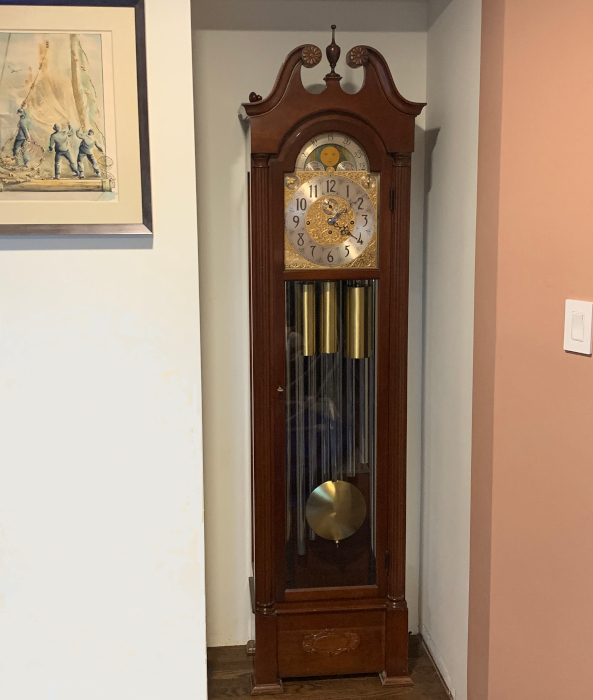
by Patrick Green
It was 1963. I was 13. It appeared in our family home with no announcement of any kind. In a passage way between the living room and the dining room it stood erect, elegant, stately, like a formal butler. But instead of serving tea, it offered up the time of day.
The grandfather's clock was six feet tall with dark, expensive-looking wood. The sides and the front of the case were glass to show off the slowly swinging pendulum with its chrome stem and large brass disc. It had a huge ornate face, registering minute and hour. There was a separate small circular dial with a little hand that ticked its way around it every 60 seconds. Three brass cylinders hung from woven brass cords that disappeared up behind the face into a jumble of gears and pullies of mechanical mystery.
As the hours and days passed these weights descended, slowly driving the mechanism. If tended properly, before they bottomed out, the clock would be rewound. The face had three slots where a key could be inserted and each weight could be wound back up. As the years passed I did this many times and I loved it. I could feel the teeth of the gears turn, meshing as my hand rotated the key. At those moments I felt like I was part of the clock.
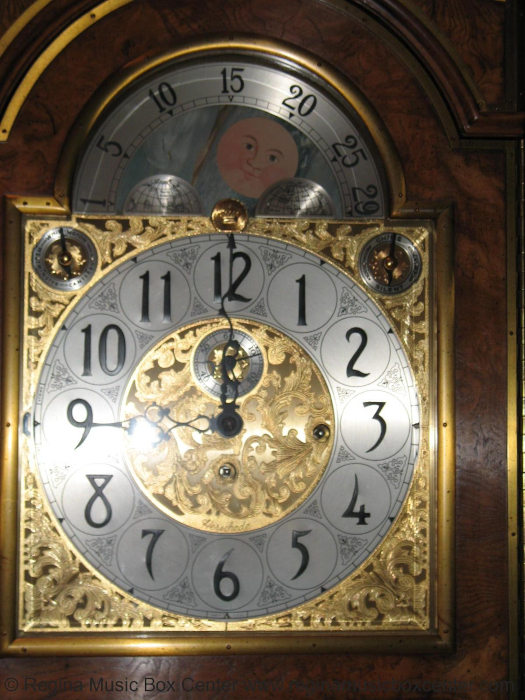
At the back of the case were eight long chrome tubes, each a slightly different length. Behind the weights and pendulum, they were not very noticeable. But at the top of the hour they took center stage. Then, hidden behind the face, little gears would turn, levers would tilt, wheels would spin, cables would tighten and eight small cotton ball hammers, each belonging to its own chime, would be pulled back. These were released to strike the chimes in a sequence that produced a tune. It was amazing to stand at the side of the clock looking behind the face at the seemingly chaotic jumbled activity and to know somehow, someone had ordered this so carefully, so meticulously, so magically, that the tune was tapped out each time by those little hammers.
There were three tunes. A dial on the face could be rotated to Westminster, Whittington or Cantebury. How aristocratic sounding, I thought. Then, of course, a lone chime struck the hour. A wheel would whir and the striker would count out the hours, slowly, deliberately, solemnly. My 70 year old self is no less astonished by all this than my 13 year old self was in 1963.
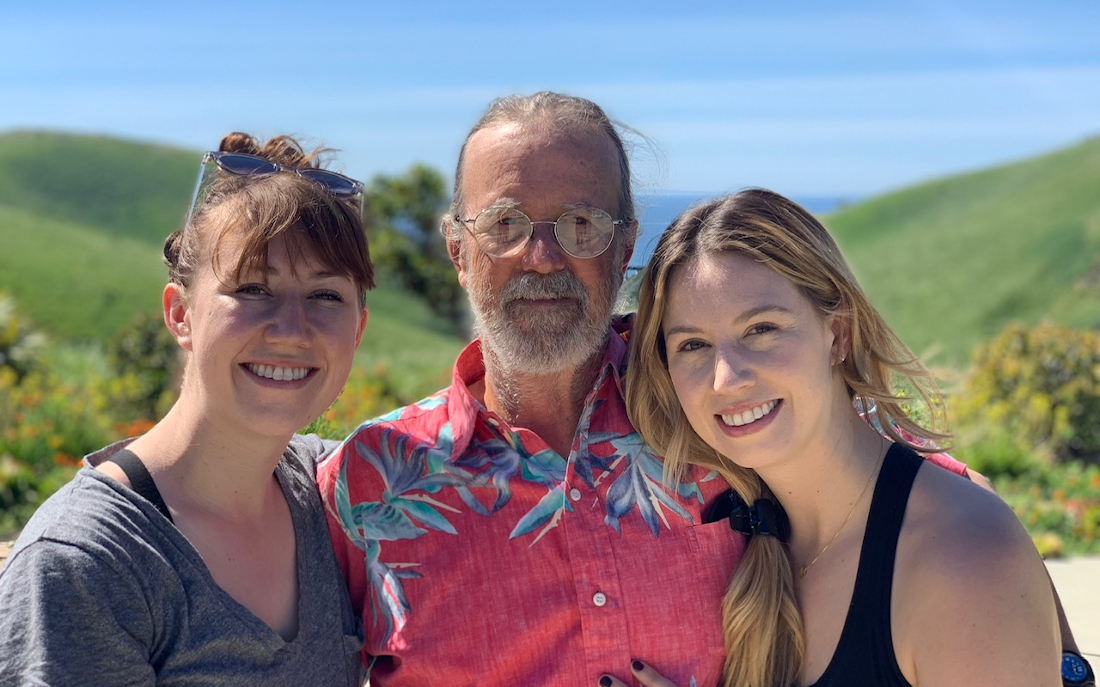
The author with his daughters, Sophie left and Valerie right
***
The clock stood in my parents' home for almost 40 years. It was a presence: its imposing size; the slow, steady, perpetual beat of the pendulum. The chimes would sound their way through the house, day and night, marking the passage of time.
In the year 2000 I had been living in Alaska for over 20 years. My father had died and my mother was moving out of the family home into a smaller apartment where there would be no room for the clock. My siblings offered it to me. Because I had been so geographically removed for so long few family heirlooms had passed to me. I gladly accepted.
The clock, disassembled and professionally packaged, found its way 3,000 miles to my home in Fairbanks. I found a clock shop and a woman agreed to reassemble it. She arrived curious to know what make of clock it was. I couldn't tell her. We unscrewed the lid of the sturdy shipping box, brushed aside a sea of foam peanuts and she exclaimed, "Oh my, it is a Heschede."
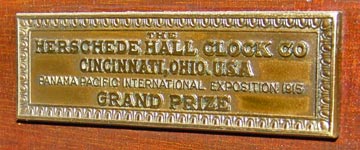
The Herschede Hall Clock Company was started in 1885 in Cincinnati, Ohio and remained a family owned business for 100 years. The clock lady told me the entire clock: wood case, chimes, weights, every gear, screw, washer, nut and bolt had been made in house. Herschede did not contract anything out. She told me they made the highest quality grandfather clocks in the United States. In the middle of the 20th century, when lower quality, often electronically driven clocks entered the market and drove down prices, the Herschede Hall Clock Company maintained their standards until closing in the early 1980s.

The pendulum swung in our Fairbanks house for almost 20 years, with my young daughters hearing the chimes as they lay in bed at night, with their heads on their pillows. Now it was their turn to stand on a chair and turned the crank to lift the weights up and keep the hands turning; to watched the gears turn and the hammers tap out the tunes.
By 2018, with our daughters long gone from the house and my wife and I in the process of relocating to San Miguel de Allende, the question of what to do with the clock weighed heavily on me. My older daughter and her husband had a house in Seattle and seemed settled enough to take the clock into their possession.
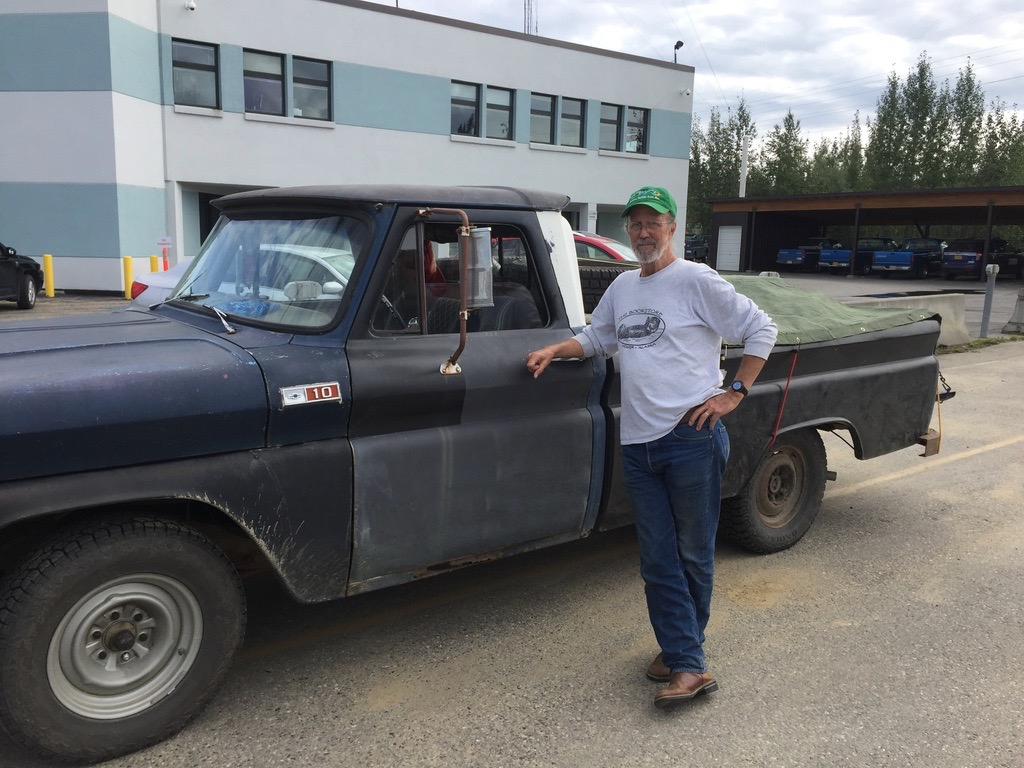
I traveled to Alaska in August 2019. The next day my son-in-law flew into town. We were to clear the last load of my possessions out of Alaska in the back of my 1964 Chevy pickup truck. I had bought that classic in 1991. Over the years I replaced both the motor and transmission. I took my girls all around Fairbanks in that truck: daycare, skating rink, elementary school, ballet class, sleep overs, middle school, birthday parties, movies... When the Lexus/Mercedes mothers saw us coming they fled for fear of carbon monoxide poisoning or maybe some sort of contamination from the plebeian class.
I picked Jay up at the airport and we went straight to the storage locker, packing the contents of that 8x10 foot space into the back of the truck. The box with the clock was too long to fit into the bed. We would have to make the trip with the tail gate down. I had a slight sense of foreboding over that precious cargo, but the die had been cast. We were on our way for a 2,300 mile trip in a 55 year old vehicle.
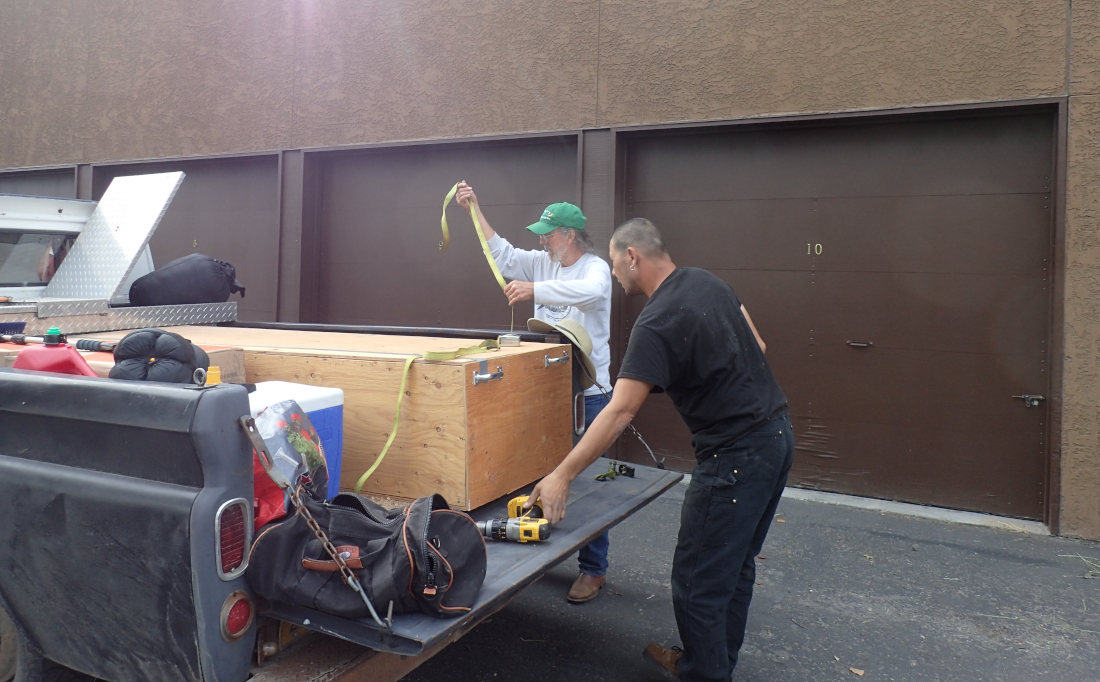
The clock lay quietly in the back of the pickup under a tarp for the whole trip. It spent nights alone in hotel parking lots in remote sections of the Yukon Territory and Northern British Columbia, unguarded. It bumped along with the rest of the cargo over pot-holed rural roads, through 12 hour marathon days covering over 500 miles. It drove past buffalo, caribou, moose and bear. It saw Haines Junction, Whitehorse, Fort Nelson, Prince George and Chilliwack.

The clock remained inconspicuous the whole trip, but my truck received a lot of attention from people we met on the road. When we crossed the border from Alaska into Canada we rolled up to a window with a young Canadian customs officer inside. He asked the usual questions. "Where you coming from? Where are you going? How long are you going to be in Canada? "Then he added with a straight face, "Of course I am going to have to confiscate the truck because I like it." He got me good with that one; border guards, even the Canadians, don't smile much less crack a joke. At campgrounds, gas stations and rest areas a parade of old guys approached us to admire and ask questions about the truck and to share memories of their own classic trucks they had owned so many years ago.

Five days after we left Fairbanks we arrived at 36th Avenue in Seattle, Washington. The clock went into a corner of the garage. I signed the truck over to my daughter. Both heirlooms passed on, the onus of being the clock-bearer off me, I continued on to San Miguel.
Some time later a photo arrived on my cell phone. It shows the clock in the living room on 36th Avenue, all the pieces back together, standing tall and alert, the pendulum swinging, the second hand ticking, offering the time to anyone who might care. What a sight to behold. The attached message informed me that in the next room was my 15 day old grandchild, Liam. It is a great comfort to me to know that Liam is growing up with those chimes in his life; that he will herself marvel at the strings and the cotton ball hammers, the gears and levers, the swinging pendulum. I rejoice that he will someday take it upon himself to insert the key and crank the weights back into place and feel a kinship with that clock. I cherish the hope that many years after I am gone Liam will pass the burden of the clock-bearer onto the next generation. Wouldn't that be grand?
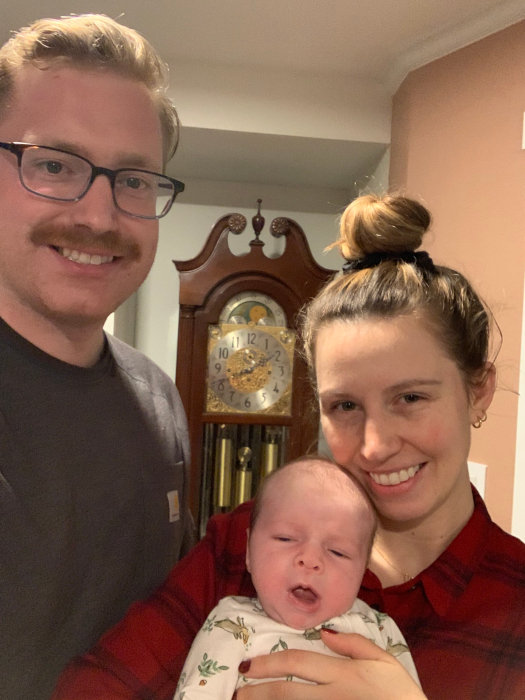
**************
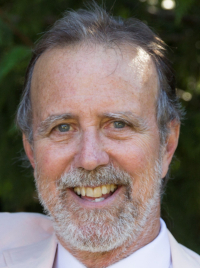
Patrick Green lives with his wife in SMA. He was born in Southern California. As a young man Patrick hitch-hiked to Alaska and stayed there for 40 years. He worked as a Land Surveyor in private practice and for the Alaska Department of Natural Resources. He retired in 2015. Patrick spends his time in SMA volunteering, studying Spanish and taking note of things both large and small.